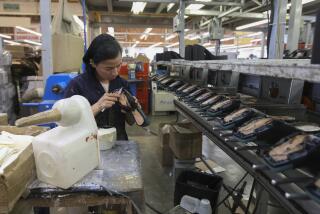U.S. Trade Gap Hits 8-Year Low During March : Commerce: The $4-billion shortfall was the result of the recession dampening imports, while exports continued strong.
- Share via
WASHINGTON — The nation’s foreign trade deficit shrank in March to its smallest level in almost eight years, with the recession reducing purchases of imported products amid a continuing export boom, the Commerce Department reported Friday.
The excess of merchandise imports over exports fell to $4 billion for the month, down from $5.5 billion in February. Imports dropped $1.1 billion to $38 billion, while exports rose $400 million to $34 billion. The deficit was the lowest since June, 1983.
The Bush Administration, which is predicting that the deficit will drop to about $90 billion this year, hailed the March figures as evidence that export growth will help rescue the nation from the recession.
“Exports are the engine of growth for the American economy,” Commerce Secretary Robert A. Mosbacher said in a statement. “While economic growth overseas has slowed, American industry clearly is building market share abroad through renewed commitment to quality and to the expansion of international markets.”
If the Administration’s 1991 trade deficit projection proves accurate, it will mark the first time since 1983 that the imbalance has fallen below the $100-billion mark. Last year’s deficit was $101.7 billion.
March imports were lower in most categories, particularly industrial supplies, capital goods and consumer products--strong indicators of the recession’s downward pull on U.S. manufacturing and domestic consumption.
Equally important, exports were strongest in those areas in which U.S. industry must remain competitive to ensure future economic growth, with capital goods, manufactured goods and high-technology products leading the way.
For the first quarter of the year, the trade deficit totaled $16.9 billion, down from $26.2 billion during the first three months of 1990. The government reported that $5.8 billion of that improvement was attributable to increased exports of U.S. goods, with lower imports accounting for the rest.
“The bulk of the improvement has come from exports,” said Stephen Cooney of the National Assn. of Manufacturers. “In March, everyone expected imports to fall because of the recession. But there is a lot of potential in export growth, and we see that as the key to getting us out of this recession.”
Although the outlook is promising, economists said the pace of improvement during the first quarter is probably unsustainable, unless the recession drags on far longer than most analysts believe is likely.
“This March number was good, but it isn’t necessarily a trend,” cautioned Cynthia Latta of DRI/McGraw Hill, an economic forecasting firm in Lexington, Mass. “The drop in imports came when the economy was still sliding. We have had a lot of inventory adjustment, especially in retail inventories in March. That showed up in the import numbers, but it’s probably only a one-time adjustment.”
The $38-billion import total was dramatically below the record $44.5 billion logged last October, when petroleum prices were skyrocketing in response to the Persian Gulf crisis. In March, low oil prices helped push petroleum-related imports down to $3.8 billion, compared to $4.1 billion in February and $6.3 billion last October. In volume terms, however, the nation imported 166 million barrels of crude oil in March, 13 million more than in February and 5 million more than last October.
More significant was the fact that the March trade deficit in non-petroleum goods was $882 million, falling below $1 billion for the first time since the early 1980s. “We can expect our national oil bill to creep up slowly, but the non-petroleum deficit has been shrinking,” Latta said.
“In March . . . our appetite for imports was weak. You don’t buy much from home or abroad when the economy is weak,” said Donald Straszheim, an economist with Merrill Lynch in New York. “For the short term, in the business cycle, the best news is pretty much over, because imports should pick up as the economy picks up.”
The strongest export growth logged in March was in capital goods, a category of high value-added manufactured equipment that includes aircraft, industrial machinery and electrical machinery. Capital good sales abroad jumped $1.1 billion to a record $13.5 billion.
Exports of advanced-technology products, such as computers, medical equipment and some telecommunications devices, were up $1.9 billion to $9 billion.
Merchandise Trade Deficit Billions of dollars, seasonally adjusted; import figures exclude shipping and insurance.
March, ‘91: 4.05
Feb., ‘91: 5.50
March, ‘90: 8.62
Source: Commerce Department
More to Read
Inside the business of entertainment
The Wide Shot brings you news, analysis and insights on everything from streaming wars to production — and what it all means for the future.
You may occasionally receive promotional content from the Los Angeles Times.










